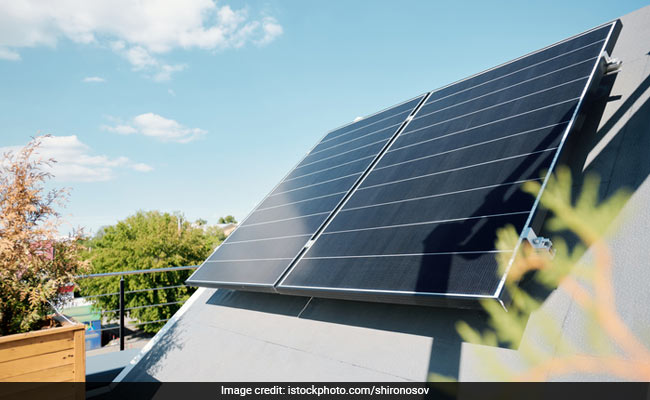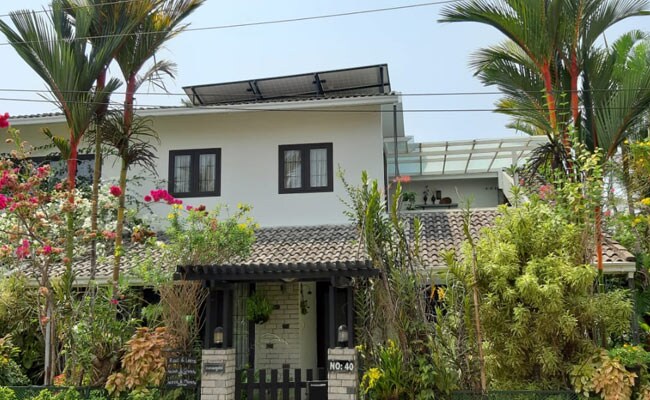- Home/
- Monthly Power Bill Of Just Rs 130, Here's How A Couple In Kochi Did It
Monthly Power Bill Of Just Rs 130, Here's How A Couple In Kochi Did It

A sprawling bungalow spread across 300 square meters surrounded by a continuous stretch of greenery only to be broken by the colourful interlude of different flowers. This is the home of Georges in Kochi's Ernakulam district. But the scenic beauty is not the only thing that sets this property apart. What makes the Bungalow special are 19 solar panels mounted on the roof of the house. The solar panels light up the Georges' household and fulfill their daily power requirement. The George family has been harnessing the power of the Sun for over eight years now and one of the most tangible benefits they have seen is their monthly energy bill has come down to Rs. 130 from Rs. 5,000 before the switch to solar.

The Georges' household in Kochi's Ernakulam district that is powered by solar energy
In a conversation with NDTV, 71-year-old Ravi George, an engineer, talked about his solar journey which dates back to 2013. He said,
The basic idea was my passion for things organic and natural and I wanted to avail the benefit of getting uninterrupted power for the house. The motivation came from an acquaintance who had just started a solar power plant business. In 2013, with an investment of Rs. 12 lakh we got our first solar power plant installed and made a switch to solar energy.
Living With Solar Energy
Switching to solar comes with a concern that whether or not solar power will be able to take the load of heavy appliances. However, in the case of George household which has two refrigerators, a freezer, four air conditioners (ACs), a washing machine, and other heavy electrical appliances that require a substantial amount of energy, solar power has lived upto the challenge. Mr George further clarified that the family didn't have to make any lifestyle change in an attempt to adapt to solar power. He explained,
Back then our bi-monthly power bill was about Rs. 10,000. Based on this it was estimated that we need 6 Kilowatt (kW) unitS to cover the entire consumption.
Also Read: Are You Planning To Switch To Solar? Before You Go Ahead Ensure These 5 Things Are In Place
24 solar panels with a maximum production capacity of 6 kW per day were installed at Georges' house. At that time, they got 12 batteries that were used to store the power generated from solar panels. Three alternating current (AC) inverters were also deployed to convert direct current (DC) power from batteries into AC power. Further explaining the working, Mr George said,
The power from AC inverters was connected to the house mains where the Kerala State Electricity Board Limited's (KSEB) power was also connected. Whenever the power generated through solar panels would get exhausted or batteries would drain out, KSEB power would take over.
The switch to solar resulted in a reduced bi-monthly power bill of Rs. 2,000 for a family of four. The installation and usage process might sound simplistic but the battery based system came with its own challenges. Firstly, the 12 large batteries, inverters and other devices that came along with it required 8 square meters of room for the installation. Secondly, batteries needed regular maintenance and care and had to be refilled with water almost every month diligently. Thirdly, the batteries were expensive and their guaranteed life was only five years.
Also Read: This Mumbai Housing Society Fulfills 42 Per Cent Of Its Daily Energy Requirement Through Solar
After four years Mr George decided to switch from battery based system to grid based system. Under the on-grid system, one doesn't need to store solar power in batteries and convert it using AC inverters. The solar power generation system is directly connected to the utility power grid. The energy generated by the solar panels during the day time is first utilised to meet the establishment's requirement and the excess or unused power is exported to the local DISCOMs' (Distribution Companies) grid on a daily basis. Similarly, if someday, like during monsoon when the power generation is less than the energy requirement, power is imported from the grid. A bi-directional meter keeps a tab on the import and export of the energy and at the end of a month, a user has to pay for the net energy consumed.
In 2018, Mr George invested Rs. 5 lakh and moved to on-grid system with 19 solar panels. Mr George said,
The on-grid system that has been on for almost two years now has been trouble free and has consistently produced minimum billing. Right now, only three of us live in the house and our monthly power bill is Rs. 130 which is the basic minimum charge implying we are not using any KSEB power.
Over time, the family also moved to energy-efficient appliances like replacing regular CFL (compact fluorescent lamp) with LED (Light Emitting Diode) bulbs. When their refrigerator broke down, they traded it for a 5-star certified refrigerator which resulted in less power consumption.
Also Read: Save Power For More Power: Five Easy Ways To Conserve Energy And Be Energy Efficient
NDTV spoke to Nassarudeen A, Deputy Chief Engineer and State Nodal Officer for Soura Project of KSEB to understand the net metering process. Nassarudeen A informed that net metering is implemented in the state and the final monetary settlement in the case of surplus units exported by a consumer is done annually.
NDTV also accessed the power bill of George household for the month of December, 2020 when power import was 521 units and export was 400 units. Ideally, the household should have been charged for the 121 units but they weren't which means they had produced surplus units in the past which has been adjusted now.
Also Read: Don't Let These Misconceptions Stop You From Switching To Solar Energy
The George's reinvestment of Rs. 5 lakh will be recovered in six to seven years based on the current tariffs.
By switching to solar, the family is not only saving money but has only reduced its dependence on dirty fuel resulting in less carbon footprint. According to J. P. Singh, founder of J. P. Consultants, a solar consultancy firm, 1 kW of solar plant reduces 26 metric tonnes of carbon dioxide (CO2) emissions in its lifetime of 25 years. Mathematically, 6 kW solar plant at George's household will save 156 tonnes of CO2 emissions per year.
When asked what advice he would give to people willing to switch to solar, Mr George suggested getting the system installed through companies that have been in the business for a long duration. He said,
There are a number of small start-up companies offering to set-up solar installations. The investment is huge and involves a number of expensive components. These small companies may shut operations before the guarantee on your equipment expires. Therefore, go only with established and renowned companies for the installation and the equipment.
Also Read: What Makes LED Lights 90 Per Cent More Energy Efficient And Environment Friendly?
also read
Solar Is The Best Economic Investment, Says Ecologist Who Has Paid Zero Power Bill For Last Three Years
Written by Aastha Ahuja, Edited by Sonia BhaskarHimachal Pradesh's The Kalgidhar Society Saves Rs. 3.4 Crore Per Annum By Harnessing The Power Of Solar
Written by Aastha Ahuja, Edited by Sonia BhaskarWhat Makes LED Lights 90 Per Cent More Energy Efficient And Environment Friendly?
Written by Aastha Ahuja, Edited by Sonia Bhaskar
About The Campaign

NDTV in partnership with Luminous has launched an awareness campaign ‘Be A Bijli Donor’ to promote the idea of ‘save power for more power’. The idea is to conserve energy today in order to get more power tomorrow.
We inherently know that saving energy results in low energy bills, but we also need to understand that a unit of energy saved today makes it available for people still living in the dark or facing regular power cuts.
Saving power or conserving energy is about knowing the sources of energy, and areas of wastage and thereby eliminating these through technology and lifestyle changes. For instance, a 100 W (Watt) incandescent (ICL) bulb can be replaced with a 9 W LED bulb offering similar performance in terms of light output, but at far lower consumption of energy.
While a 100 W ICL bulb, used for four hours a day, consumes 146 units of energy per year, a 9 W LED bulb requires only 13.5 units per year. Clearly, switching to LED is a smart choice as it provides the same output while consuming 90 per cent less energy.
The focus of the campaign is to instill the idea of ‘save power for more power’ and in order to do so, the initiative will create awareness about energy efficient products and services, smart ways to reduce power consumption, alternate sources of energy like solar energy and the need to conserve energy. The idea is to address the rising need for energy conservation in India.
As part of the campaign, we will highlight the stories of individuals and organisations who are championing the cause of energy conservation by switching to renewable sources of energy, adopting innovations to reduce energy consumption while enjoying the same output.
The initiative will provide a platform for all stakeholders to share their ideas and work towards the common goal of, ‘Save power for more power’.






